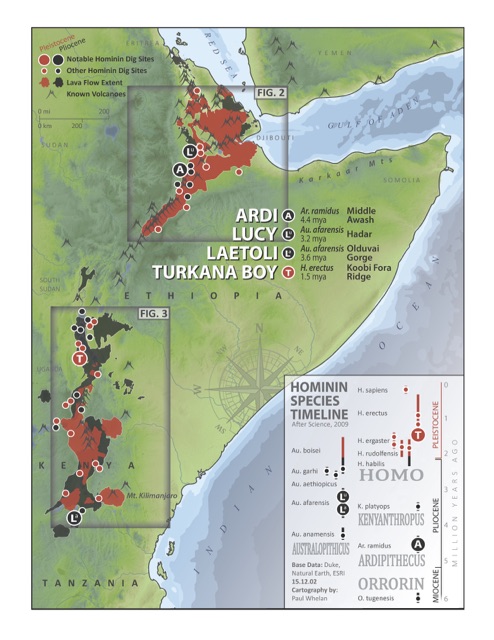
Editor's Note: This story was updated on Tuesday, Dec. 29 and Monday, Feb. 8 at 12:30 p.m. E.T.
Vast lava flows may have provided humans with access to heat and fire for cooking their food millions of years ago, one researcher has proposed.
That, in turn, would have enabled the evolution of human intelligence, Michael Medler, a geographer at Western Washington University, said at the annual meeting of the American Geophysical Union earlier this month.
The new theory would also help solve a chicken-and-egg puzzle, he added. If cooked food provided the extra calories that allowed people to evolve big brains, and big brains are required to start fires, then how did hominins, with their teensy brains and relatively meager smarts, produce fire in the first place?
"Making fire is very tricky," Medler told Live Science. "I'd argue it requires very high cognitive ability to make fire." [The Top 10 Things That Make Humans Special]
By contrast, sticking food on a pile of hot rocks or setting a twig afire by dipping it into lava requires much less intelligence, he said.
Catching fire
Get the world’s most fascinating discoveries delivered straight to your inbox.
Relative to their body size, modern humans have humongous brains. Past studies have suggested that these oversized noggins need more calories than raw meat or plants can provide. (Even modern humans can't live solely on raw food unless they have gadgets like oil extractors and juice pressers that make raw food more digestible and calorically dense, Medler said.)
In order to eke out extra calories, ancient hominins must have cooked their food, and this caloric boost would have allowed them to evolve bigger brains that required much more energy, according to a hypothesis laid out by Richard Wrangham, a biological anthropologist at Harvard University, in his book "Catching Fire: How Cooking Made Us Human" (Profile Books, 2009).
Yet, in order to cook food, early humans would have needed to somehow get heat or fire, something Wrangham spends little time addressing in his book.
But starting and maintaining fire is an incredibly complex task. (Ask anyone who has taken a survival course: A person can spend all day rubbing twigs together and only get a few sparks.) With a brain half the size of modern humans, as Homo erectus had about 2 million years ago, it seems unlikely the ancient humans would have had the ability to plan for the future and the mental flexibility to change how to start the fire — depending on the availability of sunlight, twigs and kindling, Medler said.
Environmental conditions
So Medler began wondering what environmental conditions might have been present at the cradle of life that might have helped to fuel humans' rapid evolution.
Then it struck him: Most ancient hominin sites lie in the African Rift Valley, a geological feature where the African continental plate is slowly splitting in two. And vast lava flows once oozed across the landscape.
From there, Medler began thinking about his time fighting wildfires in places such as Yellowstone National Park in Wyoming. He and his colleagues kept toasty by sleeping on spots where underground volcanic activity heats the Earth, and were able to cook their food in nearby hot springs. And in Hawaii, others on the fire crews amused themselves by sticking twigs into lava and watching them catch fire, he said. [A Quick Scenic Tour of Yellowstone National Park]
"I spent three or four snowy nights without tents, sleeping, cooking and being completely comfortable," Medler said. "That had me thinking: What would that mean to somebody 2 million years ago — to a Homo erectus or an Australopithecus — to discover there's a spot where you can hang out and be warm enough and cook food."
He wondered whether ancient people similarly leveraged the thermal features in their volcanic landscape.
To test that notion, he mapped the location of ancient lava flows and compared those to the locations where ancient hominin fossils have been unearthed. He found that many hominin sites were at the edges of these lava flows, and that the timing seemed to overlap.
"These lava flows may well have been flowing for hundreds or thousands of years at a time," Medler said.
What's more, other animals quickly adapt to volcanic and thermal features. For instance, adorable Japanese macaques (Macaca fuscata) keep toasty in hot springs on frigid winter nights. There's no reason to think humans' apelike ancestors wouldn't also adapt quickly, he said.
The ability to sleep on warm sands or other warm spots could also help explain why humans lost their body hair. Once they had a reliable way to keep warm at night, they could shed their hair and thus sweat more efficiently. That, in turn, would have allowed them to run greater distances without overheating, which would have helped the ancient hunters to chase down large animals until the animals were exhausted, Medler explained.
Circumstantial case
Still, the new theory is just a hypothesis with mainly circumstantial evidence to support it.
"The main problem I see with the lava flow idea is that these would have been dangerous in themselves and I doubt that early hominids would have accessed fire directly from them," said Terrence Twomey, a researcher at the University of Melbourne in Australia, who was not involved in the study. "However, Medler seems to be suggesting it was the indirect fires and thermal activity generated by the flows that could have been utilized, which is a great idea."
However, the idea would be difficult to test, Twomey added.
Ideally, scientists could test his theory by uncovering a precisely dated hominin site with strong evidence of cooking right near a lava field that was flowing at the same time, Medler said. Another way to test his hypothesis is to use genetic data to understand when humans evolved hairlessness or changes in the gut that would have required cooked food, and tie that to the presence of active lava fields, Medler added.
Either way, it's likely that other environmental changes, such as the ebb and flow of forest and savannah over millennia, also played a big role in humans' evolution, Medler said.
Editor's Note: This article was updated to note that Medler witnessed friends lighting twigs afire in lava flows in Hawaii; there are no active lava flows in Yellowstone National Park. The image credit included with this article was also amended to note that the underlying data on the map was partly sourced from fossilized.org.
Follow Tia Ghose on Twitterand Google+. Follow Live Science @livescience, Facebook & Google+. Original article on Live Science.

Tia is the editor-in-chief (premium) and was formerly managing editor and senior writer for Live Science. Her work has appeared in Scientific American, Wired.com, Science News and other outlets. She holds a master's degree in bioengineering from the University of Washington, a graduate certificate in science writing from UC Santa Cruz and a bachelor's degree in mechanical engineering from the University of Texas at Austin. Tia was part of a team at the Milwaukee Journal Sentinel that published the Empty Cradles series on preterm births, which won multiple awards, including the 2012 Casey Medal for Meritorious Journalism.


